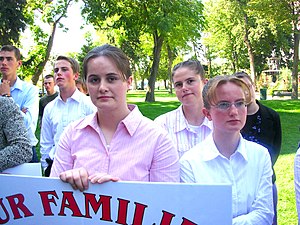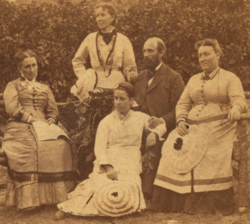
Back أصولية مورمونية Arabic Fonamentalisme mormó Catalan Mormona integrismo Esperanto Fundamentalismo mormón Spanish Mormonifundamentalistien liike Finnish Fondamentalisme mormon French Mormon fundamentalizmus Hungarian Mormona fundamentalismo IO 모르몬 원리주의 Korean Mormonsk fundamentalisme NB

| Mormonism and polygamy |
|---|
 |
|
|
Mormon fundamentalism (also called fundamentalist Mormonism) is a belief in the validity of selected fundamental aspects of Mormonism as taught and practiced in the nineteenth century, particularly during the administrations of Joseph Smith, Brigham Young, and John Taylor, the first three presidents of the Church of Jesus Christ of Latter-day Saints (LDS Church). Mormon fundamentalists seek to uphold tenets and practices no longer held by mainstream Mormons. The principle most often associated with Mormon fundamentalism is plural marriage, a form of polygyny first taught in the Latter Day Saint movement by the movement's founder, Smith. A second and closely associated principle is that of the United Order, a form of egalitarian communalism. Mormon fundamentalists believe that these and other principles were wrongly abandoned or changed by the LDS Church in its efforts to become reconciled with mainstream American society. Today, the LDS Church excommunicates any of its members who practice plural marriage or who otherwise closely associate themselves with Mormon fundamentalist practices.
There is no single authority accepted by all Mormon fundamentalists; viewpoints and practices of individual groups vary. Fundamentalists have formed numerous small sects, often within cohesive and isolated communities throughout the Mormon Corridor in the Western United States, Western Canada, and northern Mexico. At times, sources have claimed there are as many as 60,000 Mormon fundamentalists in the United States,[2][3] with fewer than half of them living in polygamous households.[4] However, others have suggested that there may be as few as 20,000 Mormon fundamentalists[5][6] with only 8,000 to 15,000 practicing polygamy.[7] Independent Mormon fundamentalist Anne Wilde investigated demographics and, in 2005, produced estimates that fell between the prior two sources, indicating there to be 35–40,000 fundamentalists at the time.[8]
Founders of mutually rival Mormon fundamentalist denominations include Lorin C. Woolley, John Y. Barlow, Joseph W. Musser, Leroy S. Johnson, Rulon C. Allred, Elden Kingston, and Joel LeBaron. The largest Mormon fundamentalist groups are the Fundamentalist Church of Jesus Christ of Latter-Day Saints (FLDS Church) and the Apostolic United Brethren (AUB).
- ^ Dobner, Jennifer (August 20, 2006). "Teens defend polygamy at Utah rally". Associated Press. Archived from the original on September 2, 2006.
- ^ Martha Sonntag Bradley, "Polygamy-Practicing Mormons" in J. Gordon Melton and Martin Baumann (eds.) (2002). Religions of the World: A Comprehensive Encyclopedia 3:1023–1024.
- ^ Dateline NBC, 2001-01-02.
- ^ Ken Driggs, "Twentieth-Century Polygamy and Fundamentalist Mormons in Southern Utah", Dialogue: A Journal of Mormon Thought, Winter 1991, pp. 46–47.
- ^ Irwin Altman, "Polygamous Family Life: The Case of Contemporary Mormon Fundamentalists", Utah Law Review (1996) p. 369.
- ^ Cite error: The named reference
DMQwas invoked but never defined (see the help page). - ^ Stephen Eliot Smith, "'The Mormon Question' Revisited: Anti-Polygamy Laws and the Free Exercise Clause", LL.M. thesis, Harvard Law School, 2005.
- ^ Hardy, B. Carmon (2011-12-01). "The Persistence of Mormon Plural Marriage". Dialogue: A Journal of Mormon Thought. 44 (4): 43–106. doi:10.5406/dialjmormthou.44.4.0043. ISSN 0012-2157. S2CID 172005470.
© MMXXIII Rich X Search. We shall prevail. All rights reserved. Rich X Search